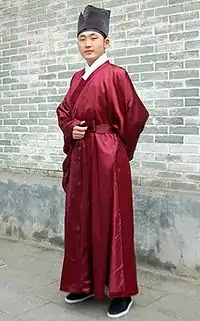Daopao
The Daopao (道袍 / pinyin: dàopáo) is a traditional Chinese garment worn by men. The daopao was made popular as formal wear in Ming Dynasty China, though its origin from before this period is debated. Despite its name (meaning 'robe of Taoism'), daopao were and are worn by all men, regardless of religious background.

The daopao is a full-length, wide-sleeved robe with side slits beginning below the waist. Side panels (暗擺, àn bǎi) at these slits conceal undergarments. A belt (大帶, dà dài) fastens the garment around the waist. The collar can be either the same or a different colour to the main pieces of fabric. However, the collar is generally the same colour as the hems. An optional additional protective collar (護領, hù lǐng, lit. "protective collar") can be sewn to the first collar. This additional collar can either be white or dark in colour.
Chinese sources indicate daopao have been worn since the Song Dynasty.[1] However, other sources state that it evolved from the military-styled tunic known as the kuzhe. This tunic was inspired by nomad warriors from the north.[2]
 Ming Dynasty portrait of men wearing daopao
Ming Dynasty portrait of men wearing daopao
See also
- Han Chinese clothing
- List of Han Chinese clothing
- Dopo (clothing)
References
- 周锡保 (Oct 1986). 《中国古代服饰史》 (PDF) (in Chinese) (2nd ed.). 中国戏剧出版社: 263. Retrieved May 17, 2009. Cite journal requires
|journal=(help) - Antonia Finnane (2007). Changing clothes in China: fashion, history, nation. Columbia University Press. pp. 44–45. ISBN 978-0-231-14350-9.